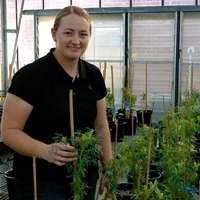New research provides understanding that helps control legume viruses

Farmers in south-west WA will be pleased to find out that a PhD candidate from The University of Western Australia has made significant advances in our understanding of major plant pathogen Bean yellow mosaic virus (BYMV).
The virus, which reduces the productivity of legume crops and pastures generally and causes the damaging black pod syndrome in narrow-leafed lupin, has been the subject of research by Monica Kehoe, from UWA's School of Plant Biology and Institute of Agriculture. Increased understanding of the basics of a virus like this helps greatly towards improving future control measures based on virus-resistant cultivars to reduce losses.
In two papers recently published in the prestigious journal PLoS ONE, Ms Kehoe obtained whole genomes of plant viruses and described innovative methods to make analysis of the large data sets that resulted from this work much more user-friendly. She characterised many new variants of BYMV, and provided critical insights into how the virus changes to invade new host species.
Recent innovations in new technologies mean it is now much faster and easier for virologists to sequence whole virus genomes.
"I used a technique known as next generation sequencing to sequence 23 new complete genomes of the major plant pathogen BYMV which add to the 17 complete genomes already known," Ms Kehoe said.
"Having 40 whole virus genomes instead of just 17 to study meant the picture was far more complete and showed strong support for the existence of nine distinct phylogenetic groupings of BYMV. This changed our thoughts on how the variants of the virus can be classified, so we devised a new system which overcomes the flaws in the current system which is no longer sustainable."
PhD supervisor Professor Roger Jones (from the Department of Agriculture and Food WA and UWA) said the challenge was not in accessing and using next generation sequencing, but in analysing and interpreting the very large datasets that this provided.
"Previously, virologists needed to be expert bioinformaticians to analyse such datasets. Where Monica has excelled is in providing critical recommendations to other plant virologists in how to analyse next generation sequencing data effectively which can be applied to other economically important plant viruses," Professor Jones said.
"In just one example of the interest generated, a peer from Washington State University let us know he would be placing a major focus on Monica's papers in his teaching material next year, showing how this work is very current and widely applicable."
Ms Kehoe's research has also provided critical insights on the evolution of BYMV and how the virus invades new hosts.
"It was previously thought that recombination between different variants allowed them to become highly specialised and specific to one crop. My research revealed that the reverse is likely and that recombination is associated with variants that are suited to more than one type of crop," she said.
These recombinant strains have the potential to become far more virulent and infect additional crops worldwide."
More information: "Plant virology and next generation sequencing: Experiences with a Potyvirus" is available online: www.plosone.org/article/fetchO … ject.action?uri=info%3Adoi%2F10.1371%2Fjournal.pone.0104580&representation=PDF
"Split personality of a Potyvirus: To specialize or not to specialize?" is available online: www.plosone.org/article/fetchO … ject.action?uri=info%3Adoi%2F10.1371%2Fjournal.pone.0105770&representation=PDF
Journal information: PLoS ONE
Provided by University of Western Australia


















